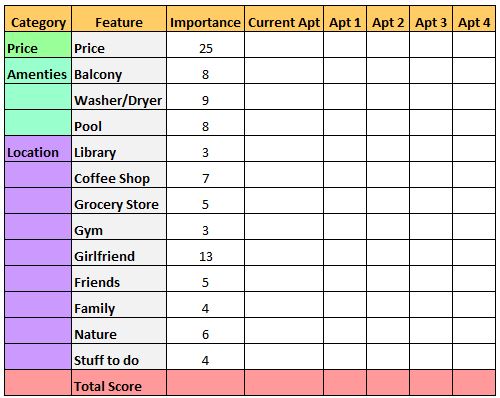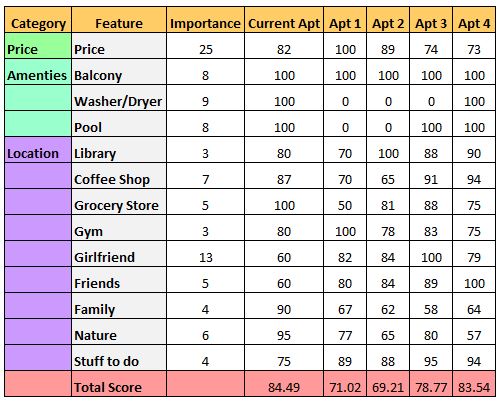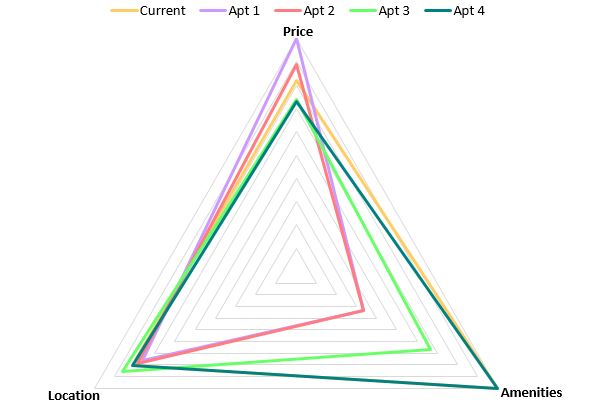
5 min read
The lease on my current apartment ends in two months, so management recently sent me a letter asking if I planned on renewing it for another year or not.
I had a decision to make. Should I stay or should I go?
To help make my decision, I decided to nerd out and use some math.
The Three Categories to Consider
There were three basic categories I had to consider when thinking about which apartment I should live in:
Price
My goal was to keep my monthly rent payment below $1,000 for a single bedroom apartment. Fortunately, Cincinnati is one of the most affordable places to live in the midwest, so this meant there were plenty of places that met this requirement. For reference, the monthly rent on my current apartment is $888.
Amenities
I don’t actually care about square footage that much. I’m perfectly content to live in a fairly small place as long as it has the following three things:
- Balcony – I love sitting outside and reading, working on my laptop, and enjoying the weather. With the exception of winter, you can find me out on my balcony during most evenings for about eight months out of the year.
- In-house Washer & Dryer – I’ve been spoiled by having a washer and dryer in both of the apartments I’ve lived in over the past few years. While I could probably adjust to using a washer & dryer facility, I prefer the convenience of having these amenities in my own place.
- Pool – Some people couldn’t care less about whether they have a pool or not within their apartment complex. Not me. Unless there’s a torrential downpour or a tornado on the radar, you can find me at the pool virtually every day in the summer. I love listening to podcasts, reading books, and lounging around by the water as much as possible.
Location
The third category I considered was location. Specifically, I wanted to be reasonably close to all of the following things:
- Library – I rent a couple new books from my local library every few weeks.
- Coffee shop – Starbucks doesn’t count. I prefer boutique coffee shops that are less crowded and fun to write in.
- Grocery store – I go grocery shopping about three times per month. It’s convenient to have a grocery store fairly close by.
- Gym – I prefer to work out in public gyms. It helps if the gym is nearby.
- Girlfriend – I probably spend more time with my girlfriend than anyone else, so it was a priority for me to live within 15 minutes of her apartment if possible.
- Friends – I have a small circle of friends that all live in different areas of Cincinnati. Ideally I wanted to live in an apartment that was fairly close to most of them.
- Family – My parents and siblings live about 35 minutes away from my current apartment. If I moved, I wanted to still live within one hour of them since I visit them two or three times per month.
- Nature – One of my favorite activities I love to do in my free time is go for a massive walk in a public park or nature reserve for an hour or longer. If possible, I wanted to live close to one or more places where I could do this.
- Stuff to do – Midwest cities might have a reputation for being lame, but Cincinnati bucks this trend. It has major sports teams, festivals almost every weekend, free concerts in the city, tons of public parks and nature reserves, several rivers for kayaking, and as many bars and breweries per square mile as almost any city. I wanted to live reasonably close to a lot of these things.
So, I knew that I had to consider each of these three categories when shopping for a new apartment. Next, I simply needed to quantify the importance of each of these categories.
The Math I used to Decide Where to Live
In total, there were five different apartments I seriously considered, including my current one.
I decided to rate each apartment that I looked at on a scale of 1 to 100. I quantified each of the bullet points listed above based on how important I considered it to be. Here’s what I came up with:

Price was a massive factor, so I gave it an importance score of 25. Being close to my girlfriend was also an important factor for me, so I gave the distance to her apartment a score of 13.
Then, each of the other things I considered received scores between 3 and 8 based on how important they were and how frequently I would use or visit them. For example, I knew that I would go to a coffee shop to do some work about four days per week, so that received a higher score (8) compared to the library (3), which I would only visit once every two weeks or so.
In total, all of the importance scores added up to 100.
So, for each of the five apartments I gave a ranking of 0 to 100 for each feature and then took a simple weighted average using the importance score for each feature to find the “total score” for each apartment. The higher the number, the better.
Here were the final results:

Here are the formulas I used for those who are curious:
Price
The apartment with the lowest monthly rent that I considered was apartment 1, which had a monthly rent of $725. I gave this apartment a price score of 100, since it deserved the best score possible.
Then, I used the formula ($725 / Rent) * 100 to determine what score to give to the other apartments. For example, my current apartment has a monthly rent of $888, so it received a price score of ($725 / $888) * 100 = 81.6. I then rounded this to the nearest whole number.
More expensive apartments received lower scores while cheaper apartments received higher scores for this category.
Amenities
If an apartment had a certain amenity, it received a score of 100. Otherwise it received a score of 0. Nice and simple.
For example, my current apartment has a balcony, washer & dryer, and a pool, so it received a score of 100 for each of these three.
Location
I used the same approach to rank the location categories as I did with the price category. I found the number of miles to the nearest library, coffee shop, grocery store, etc. for all five apartments. Then, I gave a score of 100 to the apartment with the shortest distance to each place and then ranked the other apartments in relation to this shortest distance using the formula (Shortest distance / Specific apartment distance) * 100.
For example, there is a grocery store only two miles away from my current apartment. Thus, my current apartment received a score of 100 for grocery store. For apartment 1, however, the closest grocery store was 4 miles away, so it received a score of (2 miles / 4 miles) * 100 = 50.
I repeated this process for each feature for each apartment.
Visualizing the Results
One interesting way to view the results is to look at the average score that each apartment received for each of the three categories:

My current apartment was in the middle of the pack in terms of price, but it tied for the highest amenities score and the second highest location score.
One neat way to visualize how each of the apartments scored across these three categories is with the following radar chart:

Each line represents a unique apartment and the further out a line is from the center, the higher the apartment scored for a particular category.
For example, we can see that apartment #2 (the pink line) scored fairly higher for location and price, but it scored poorly for amenities.
By contrast, my current apartment (the orange line) scored very high on amenities, pretty high on location, and right in the middle of the pack on price.
We can also see that apartment #3 scored the highest on location, but it scored low on both price and amenities.
I’m Staying Put
At the end of the day, my current apartment received the highest overall score of 84.49, just edging out apartment #4 for the top spot.

I ultimately decided to renew my lease for one more year at my current apartment because running these numbers made it clear that my current apartment offers the best mix of all three categories I considered: price, amenities, and proximity to places I go and people I care about.
- The Ad Revenue Grid - August 6, 2021
- Attract Money by Creating Value for a Specific Audience - July 13, 2021
- The 5-Hour Workday - March 26, 2021
Full Disclosure: Nothing on this site should ever be considered to be advice, research or an invitation to buy or sell any securities, please see my Terms & Conditions page for a full disclaimer.
